Lady Bird and the White Polo: An interview with Costume Designer April Napier
Culture — 12.01.18
Interview: Nan Collymore
Special thanks to April Napier

Costume designers are often not celebrated for their art. Attention is placed on the director and the actors, but the way a film makes us feel and how deeply engaged we are with it is also manifestly shaped by how the cast is attired. Lady Bird, Greta Gerwig’s directorial debut, is a highly intelligent film that centres on the relationship between the main character, ‘Lady Bird’ (Saoirse Ronan) and her mother, Marion, played by Laurie Metcalfe. The film won two Golden Globes this last week and is set to win more awards at the BAFTA’s, assuredly the Oscars, and April has been nominated for best costume design at the Costume Design Guild Awards, alongside I, Tonya and Get Out.
To position the film in the subgenre of Mumblecore would not do it justice. It is a sensitive portrayal of the triumphs of growing up, hilariously funny in parts, but also maudlin and often staggeringly candid – I cried through most of it.
The astutely assembled styling entirely transposes the drab setting of early 2000 Sacramento. From the hot pink plaster arm cast to the belted pegged trousers, the film is a visual feast. April Napier is a stalwart in the costume design industry. From music videos to feature-length films to advertising, her highly individualised style has appeared in them all. Her incredibly focused eye for detail, her previous film was Kelly Reichardt’s Certain Women (2016), and her sheer love of fashion shows up in her work. The way she communicates character through her costume design is poignant and exhaustive. She has a deep understanding of clothing akin to a fashion historians. I spoke with April, at the end of December about the film.

Pucci (Aprils dog who plays Brambles) and Saoirse Ronan
Nan Collymore: I love the styling in the film. The clothing was almost like a character as the character herself develops. How much did Sacramento inform your costume choices?
April Napier: The film is set in Sacramento in 2002/2003, where Greta grew up, so it’s that moment when people are starting to use the internet but not wholly. It was a time when people were saying ‘do you have an email address’ as opposed to ‘what’s your email address’. There was a bit more freedom in discovery, of making mistakes then, before we became consumed. Greta always described Sacramento as the Midwest of California because it is separate, it’s not like Los Angeles it’s not like San Francisco, it’s always a little bit behind. It’s in the Central Valley and a little bit behind the times, so even though the film is set in 2002, in Sacramento it’s the late 90’s, so everything is a little slower and a bit behind the times. And I used that reference for the overall flavour of the background and the extras and the people who were carrying LadyBird (Saoirse Ronan) through her year-long journey.
And the story resonated with me too, even though, you know, I graduated twenty years before that, I went through the same things. My journey was in Punk Rock, and I was still going through that moment of figuring out who I was and what I was doing and making mistakes and stumbling and trying different avenues, and I have this suspicion that even the women of the Bauhaus in the twenties and the thirties were telling a similar story. I feel like there have always been these places where women, specifically, can falter and stand firm and it’s interesting that it is happening in this scary time also because it seems like women are right now standing tall.
NC: And how do you think that’s reflected in today’s culture, in terms of clothing?
AN: Someone interviewed me a few weeks ago and asked me what Lady Bird would be wearing now. Well, Lady Bird is drawing on a lot of references for the film. I looked at Larry Clark’s Kids, from 1995, even though it was earlier than that it made sense for her with that kind of Chloe Sevigny character, the kind of Kathleen Hanna character, the Patti Smith character – she’s free-thinking and interested in literature and self-discovery, and she’s trying to explore who she is. When I think about now, there is an era of people right now who are standing with individuality, you know like Election Reform (Brendan Fowler’s artistic endeavour) there’s a whole group of artists and creators who are drawing and painting and making clothes and skateboarding and that culture still exists. I think it’s difficult to be immune to the internet in some way, but I do feel that there are some people who are standing strong and willing to stand out through difficult times.
Lady Bird is shopping in thrift stores wearing used clothes, and it is interesting that you say that the clothing was kind of like a character because costumes are always the things that are supporting the characters; they’re always supporting the story that’s going on. And a lot of Lady Bird’s story is about her figuring things out, and that’s shown up a lot through clothing. I mean we made decisions all the time, when I was a kid, about presenting yourself and figuring something out. I think it’s also very important in costume design to use things that are old and things that are used. That’s the way to have some nuance and to have that subtlety with costumes because then it really looks like something that’s actually been worn. I very rarely use something new, and if I do use something new, I wash it down and make it look like its old. New clothing doesn’t have that old feeling like it’s not stretched out because it hasn’t been on the body that much. They have a certain patina when they’ve been used.
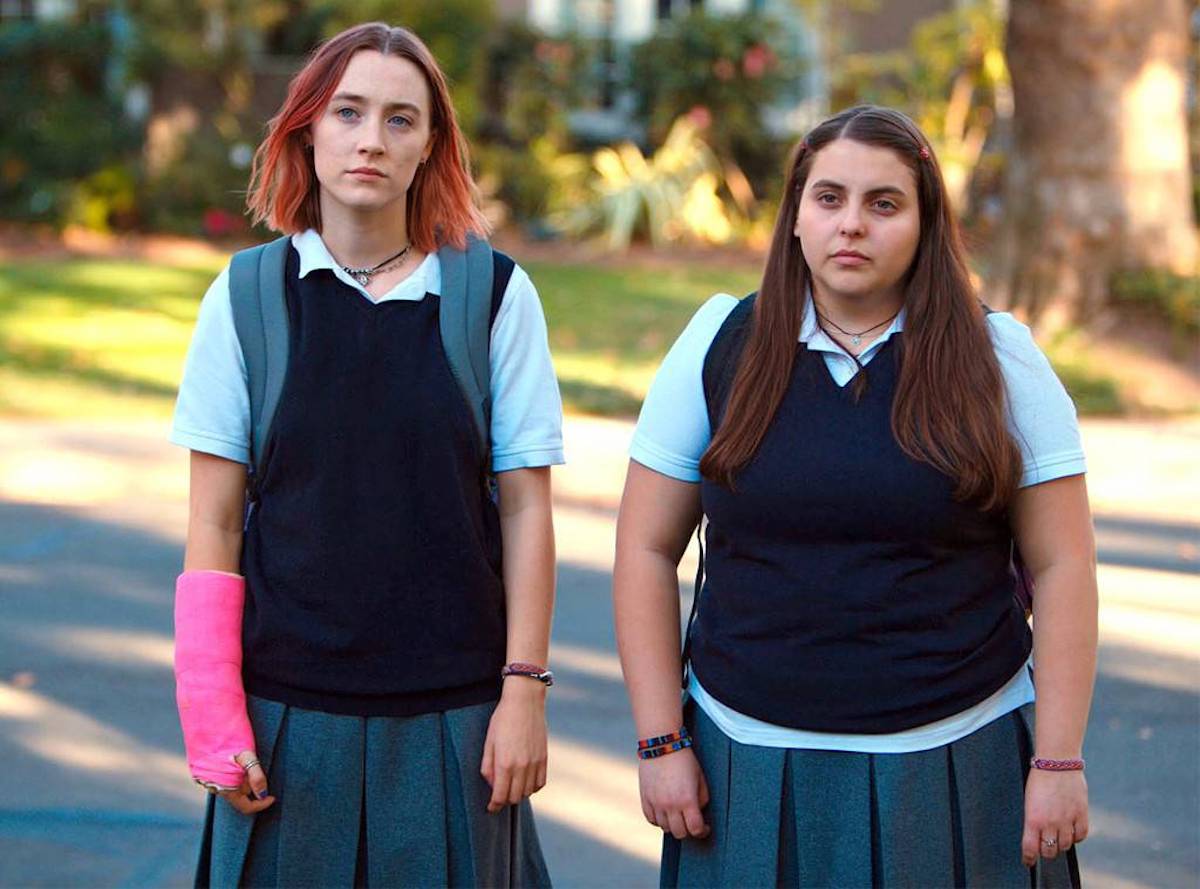
NC: I’m thinking about specific items, like the white polo shirts. It’s fascinating to me how the polo shirt has such a powerful cultural identity, here I’m thinking of Kanye West, yet the film is set in a time just a few years before his polo shirt travails. Obviously, here, it’s a school shirt, but she transports the shirt into something very much her own.
AN: Well it’s also about the way she wears the polo shirt too isn’t it? Lady Bird and her friend Julie (Beanie Feldstein) and Odeya Rush who plays Jenna wear them in very different ways. It was important to us because Greta always said that uniform was the great equaliser – everyone gets issued the same thing, but it’s how you wear it and what you accessorise it with. So, for instance, Lady Bird wears hers oversized, kind of tomboy style and she wears loud or patterned socks and Doc Martens or Mary Janes. Then she accessorises with the little leather bracelets, layered and layered necklaces that give more of an alternative cultural element. And then Jenna (Odeya Rush) is kind of the rich girl, and she wears hers very tight and too short with a gold tennis bracelet and the single Tiffany solitaire ring necklace and those knee-length socks and loafers. Whereas Beanie is kind of the sweet girl, so she wears cute hair clips and those awful Sketchers (we laugh). I really thought you know, I have a friend Casey Storm, who is a costume designer too, and that’s one thing we always said we would never do is put Skechers on a character and this time I thought I’m doing it! (we both laugh)
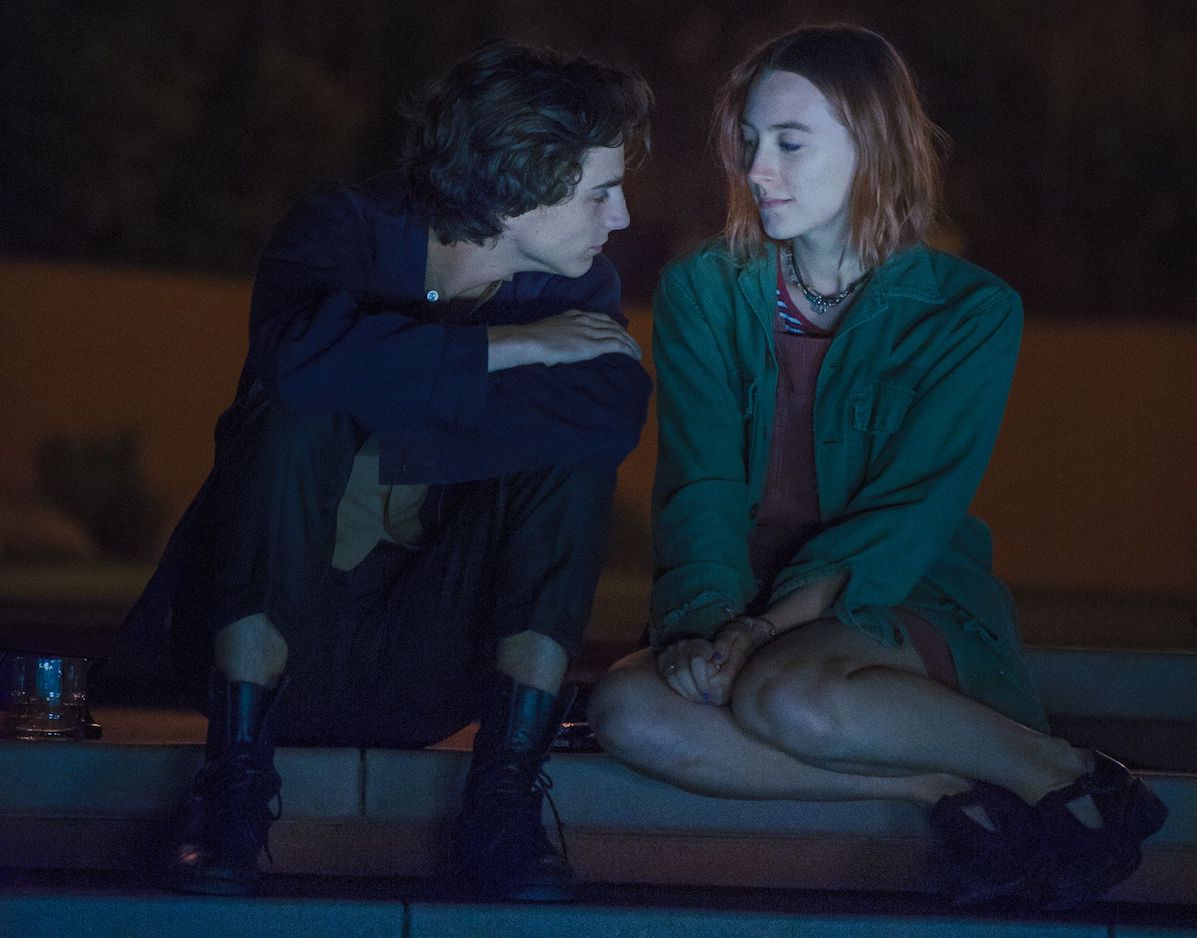
NC: Yes, I can see that it’s important to stay true to the character right? It’s very much about cultural groupings and affiliations. Following on from that, I feel like in the US as opposed to the UK, that cultural categorisation is really emphasised in high school. And I feel like you really nailed it with the indie kid, the preppy kid, and the theatre kids – how much research did you do or was it from your own personal experience?
AN: The character that plays Kyle (Timothée Chamalet), my biggest reference for him was the book A Scene in Between (Fletcher et al., 2013). It’s a style book that’s set in the early nineties and pictures the Marine Girls, The Jesus and the Mary Chain, and My Bloody Valentine and that was my era and what I was into, so I really connected with that music and I really connected with that vibe and I used that book for Kyle. I also used Ian Curtis as a reference, because he was iconic, you know. Kyle is reading Howard Zinn, he’s got something to say, he’s independent. He’s got on old army boots and men’s 60’s cropped trousers that are too short. The clothes just also fell on his body so perfectly, I could just get something off the peg, and it just looks beautiful on him. But it was interesting to use different references for different people. I did everything from Kids (Larry Clark, 1995) to A Scene in Between to Kirsten Dunst – from when she was on the cover of Teen Vogue – to Chloe Sevigny of that era, Ani DiFranco, Bikini Kill, Fiona Apple. All of those things and somehow they’re all late nineties, but somehow they still influence Lady Bird’s character.
NC: I felt like my favourite look was on the goth couple, Miguel and Shelly (Jordan Rodrigues and Mariella Scott). I thought you managed to depict their inner lives through their wardrobe, and it was so striking. Their clothes really reflected their mood and attitude, what was that like and did you have fun playing with their style?
AN: I felt like I didn’t want to push it too far. I remember doing a lot of research on the internet on goth couples, and it became too insane. My preference is using photographic books, picking pictures, making photocopies, and then making a hard book that I present to the director, but it seems like there’s never time for that, so I was like alright when you use the Internet it’s about using the right search words. Most of the couples that I saw on the internet were too shaven or too pierced, with too much make-up and they weren’t that because they still live in that small town. So they just have one nose ring and one lip ring and one eyebrow ring and then we made the matching outfits. And the reference that I used for that was actually a random picture that I found of Shia LaBeouf and his girlfriend. The picture is of them walking down the street in New York City both wearing blue pullover hoodies both of their hoods are up with big denim shearling jackets over the hoodie and jeans, and they’re wearing the same outfit. So the difference is that it’s blue and denim, but I thought that that was the right vibe, and so then I translated that into darker clothes. Because they were written like that they were written to match and to be darker, you know. I love when LadyBird says you know you’re never going to get a job with all that shit in your face and obviously the script steers you so much in the right direction.
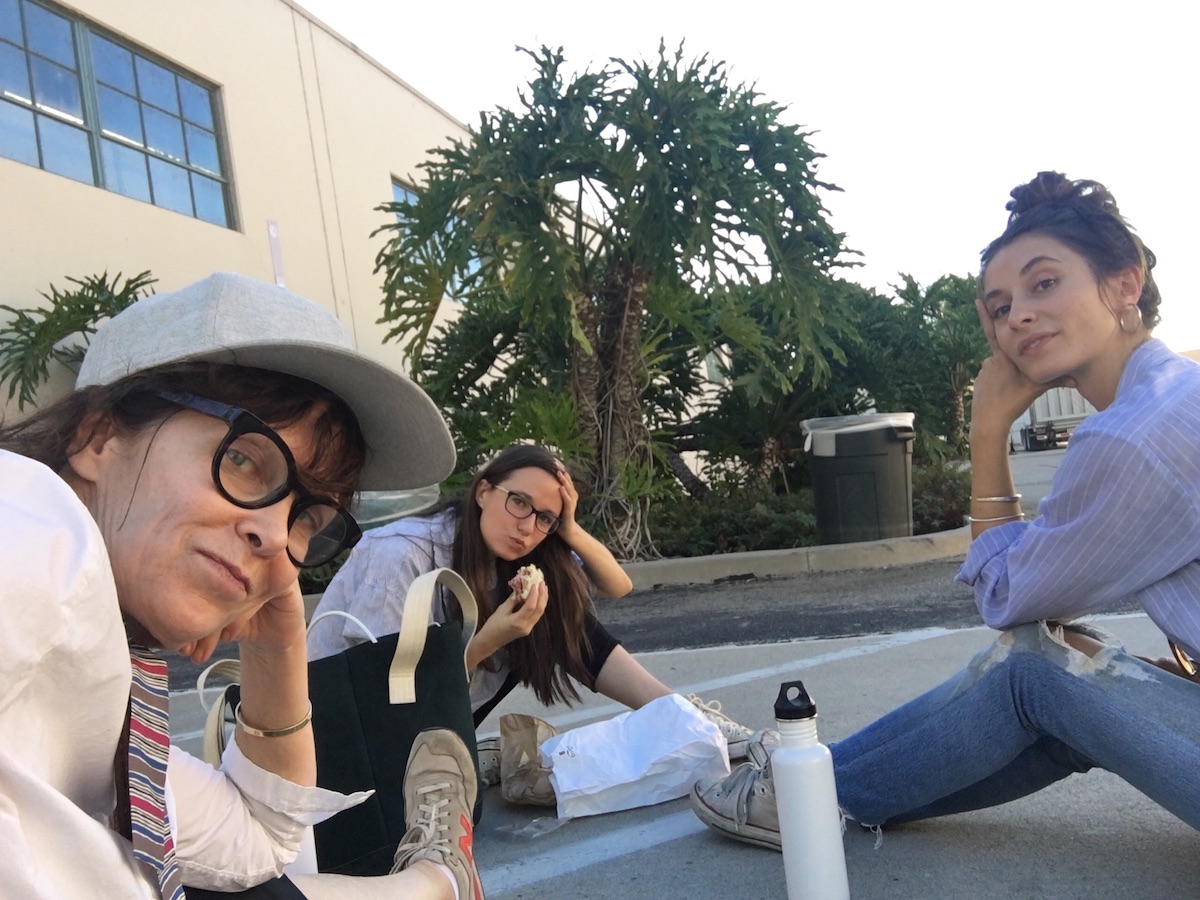
April Napier and her assistants Katina Danabassis and Coral Cunningham
NC: I was wondering about that – how much involvement did Greta have in the styling?
AN: There was nothing specifically referenced in the script. The first time I met Greta because I’d never met her before, our agents put us together for a meeting. I was waiting in the restaurant, and she came in, and we were wearing the exact same outfit – white men’s button down shirt with black high-waisted jeans, black Oxford lace-ups and we both had on a black backpack (we both laugh). It was like ‘hello’, so right from the get-go we connected. I had made some kind of small lookbook for her to look at on my iPad of references and we had a sense of kinship a sense of understanding. It was really effortless working on the film, she’s such a supporter and collaborator she really trusts what’s happening, and I had a great support team. It was really low-budget so it was hard to find a crew, and I ended up getting these two assistants I’d never met before, Katina Danabassis and Coral Cunningham, and they were so solid. The three of us were this trio, so in sync and so together, and I felt so supported by them. It was great knowing that I could turn around and know that someone had my back and knows my needs because there was so much thrifting, you know, we went to flea markets, thrift stores Etsy – the biggest thrifter in the universe. Then we went to lots of costume houses because Lady Bird has so many eras she’s not bound to the era that she’s living in because she’s free to be in any era you know, 60’s 70’s 80’s 90’s and she’s just choosing what is appealing to her at that moment which is why it’s so nice to have her actually thrift shop in the film.

NC: Her mom’s response to the dress she tries on is so interesting.
AN: It was heartbreaking because what if this is the best version? And when they’re having that confrontation ‘you’re so irritating, why do you have to say that, you’re being passive aggressive, what do you think about this dress…Oh, it’s fabulous…’
I think it’s such a great film to go and see and all mothers and daughters and fathers too should see it because the father is such a rock, you know. Are they too poor maybe to divorce, there’s so much going on for him, he’s so quiet and meek.
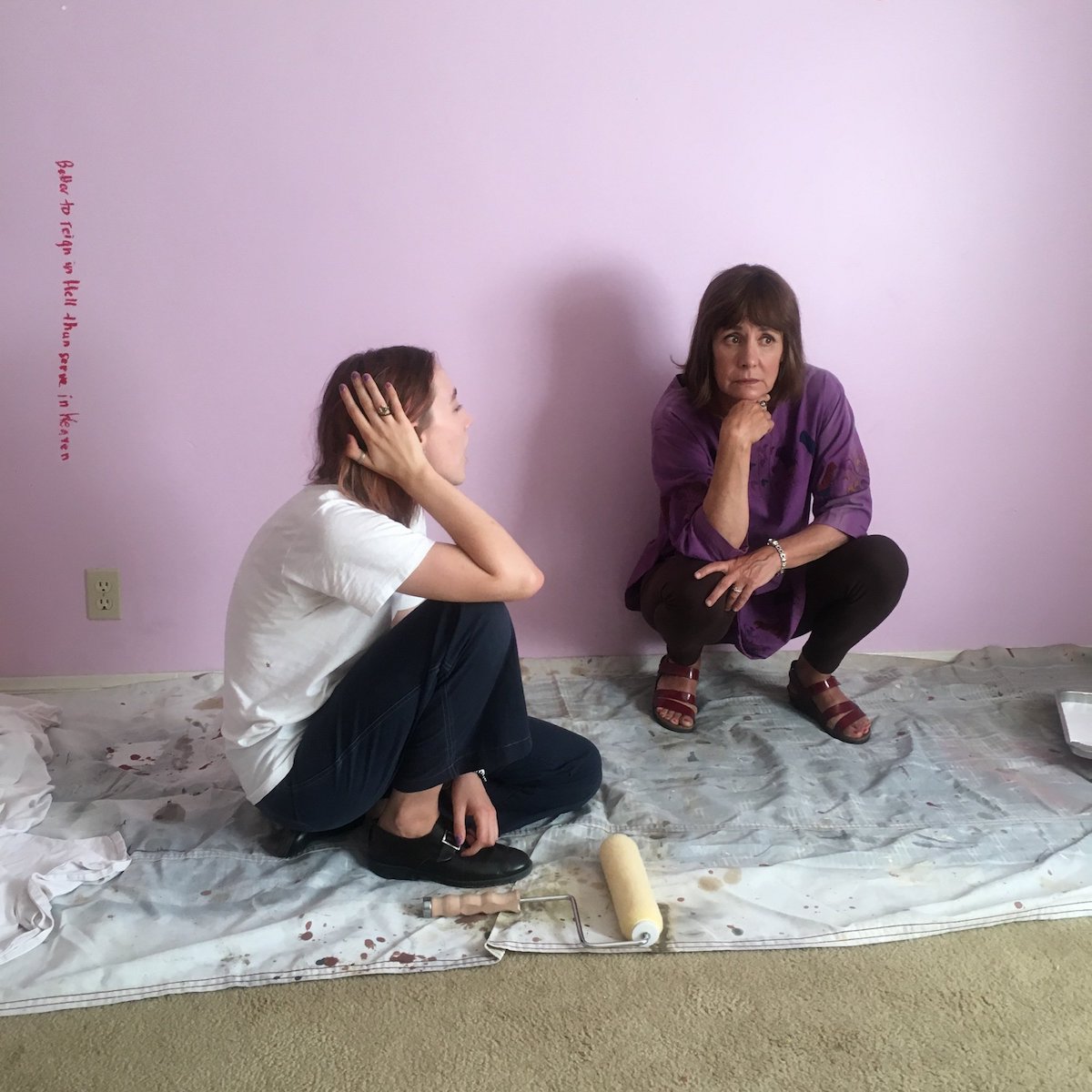
NC: Yes Tracy Letts played that role really well. I thought that the mum, Laurie Metcalfe, had such an unusual look. Tell me about your choices for her. Because she’s in a small town, and yet she sometimes dresses in pretty ornate and striking ways.
AN: Yes, you know Greta talked a lot about that and I think that when we were talking about that character she was thinking a lot about her mum because I would never have thought to put her in so many patterns and so many layers of loud jewelry, but not too loud just unusual or creative in some way. Greta’s mum is like that; she wears beautiful ethnic-inspired clothes and things that are a bit more creative and colourful. So when it came to dressing Laurie, it was a weird balance because you don’t want it to be too out there, so I had to make sure that what she did wear appeared natural.
NC: Because she could have been quite dull because of her demeanour and her attitude towards Lady Bird, but actually there’s something about her that’s still quite attractive and you’re interested in her.
AN: In a more subtle and quiet way, yes. You could see her frustration because she has that underneath her, she has a spark and she’s just trying to do the right thing. It’s a beautiful story of the mother and of how she’s navigating that role.
NC: And then it makes you think about her past, maybe she was a creative person like her kid is and maybe that’s why she is suppressing those aspects in Lady Bird. How did you change the clothes to suit the mood? It’s such a moody film, there’s so much laughter in it, but there’s so much sadness and darkness – how did that work?
AN: Yeah that’s interesting because I just saw that it was nominated for the Golden Globe in the comedy section and I wondered, is Lady Bird a comedy? To me, it’s just kind of a narrative film that has laughter and joy in it and also sadness and terror and frustration. I don’t think I thought about that, you know, separating the elements of all of those different emotions. I think all of those moments can contain each other, there’s no separation between those moments even when there’s laughter there’s sadness, and even when there’s sadness, there’s joy underneath it somehow. Maybe I just think like that because I’m a Buddhist and there’s no dualistic thought because I feel the same things are happening at the same time.
NC: Tell me more about her socks.
AN: She had this whole row of socks that we used. We had six or seven different pairs that we used and we just must have traded them out. But we would always look for something different, some kind of bold patterns in contrast to Jenna who has solid colour knee socks. We used stripes or Argyle for Lady Bird and Julie who wears the no-shows. We showed the individuality of LadyBird through the socks.
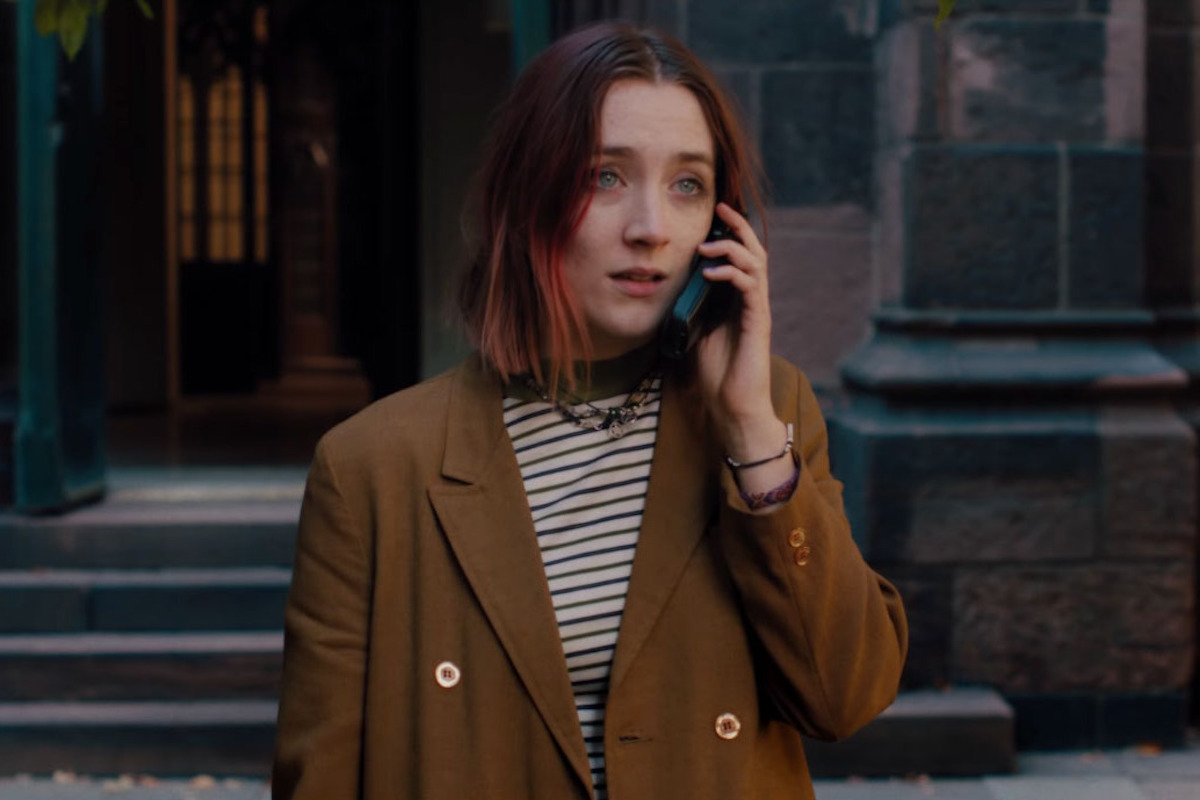
NC: It makes it so clear about how to identify the different characters, it’s really clever.
AN: Well, it was really important because of the storytelling aspect. It was actually impossible to find clothes from that era. I just read an article sent to me by Sam Levy (Director of Photography) that said that Lady Bird will make you crave the early 2000’s fashion and I thought ‘oh no I’m sorry to go back there’, because there really was no style, it was such an unattractive era, like the guys with their ill-fitting jeans, that Danny’s (Lucas Hedges) wearing those clumsy sweaters, ugly layers, and Abercrombie – blaaah. And the girls were wearing bootcut jeans and when I was doing my research I was like ‘oh yeah Juicy Couture’ and the jumpsuits right? And crop tops.
Actually Coral was telling me the other day her favourite scene was after LadyBird has sex with Kyle, and she’s coming outside and her mum collects her in the car, and she starts crying and her mum says whose sweater is this and she says it’s my friend Jenna’s and she’s wearing the pale pink velour hoodie and her vintage plaid skirt and a little ivory button-up polo, and it’s those little subtle details because that’s what makes you differentiate the characters.
People always ask me what my favourite costume is and I say when she first arrives in New York because she’s clear and she’s figured out her identity, you know, ‘I’m Christine’, and she’s declaring who she is. There’s a strength in that, and I also really like the one where she’s auditioning. It’s that knit acorn dress, it’s a 70’s kind of dress, and that’s kind of the beauty of costume because you create such an effortless look. You certainly have to have pieces that are striking, like the audition dress, but things that are subtle and have nuance and that have a worn authenticity is what makes it real.
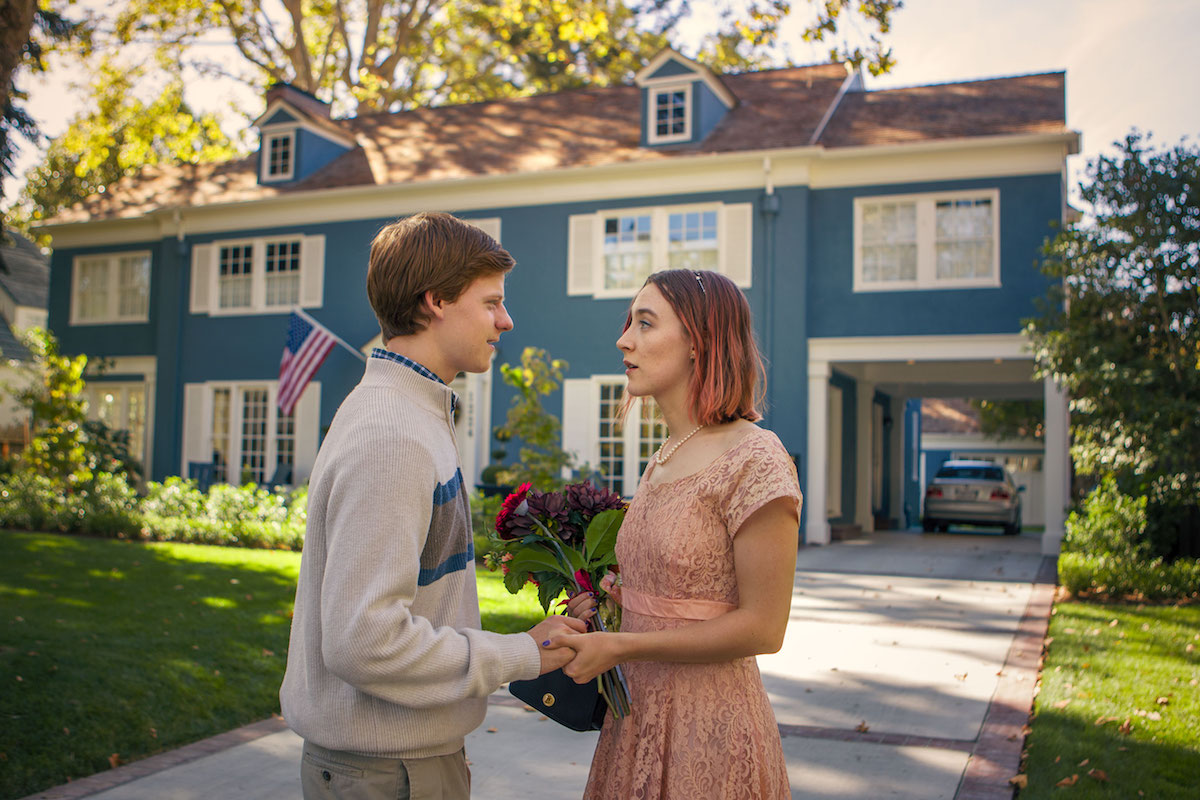
NC: I think that’s an interesting point as well about the early 2000’s because I keep wondering what were people wearing and it seemed like that was the beginning of repeating what had already gone before?
AN: I mean, I think that fashion is recycled all the time because, of course, the only people I can think of are Vivienne Westwood and Malcolm McLaren where I don’t feel like that had ever been done before. I think that’s one of the only times that has happened. Maybe it’s referencing some kind of Dada or Situationist era or some kind of political movement, but really not torn up with safety pins and stuff. But the interesting thing about looking for early 2000 clothes is that it’s not really an era yet. In the thrift stores, you don’t really find it; you find some things. In costume houses, they’re really helpful because they’re separated by decade but there’s no 2000 section because no one’s quite sure yet what that was, so you kind of have to dig through everything to try and find the one piece. I did find these kind of stripey zip-front polo shirts. There was a green one, and she wears a blue one, but there are all of these clothes in this costume house and they take beautiful care of their clothes, everything is in such good nick, but even there the ones from 2000 the clothes were falling off of the hangers they were yellowing and getting stains from the hanger the on the shoulder and fraying and coming apart. Then I thought this is the start of fast fashion where we have H&M and Urban Outfitters but you can find a 1950’s dress and it’s in beautiful condition, it’s 60 years old, 70 years old, it’s been worn and dry-cleaned a million times but it’s still sticking together.
But, you know, the sheer joy of working with such an extraordinary script and having the financial struggle with it being low-budget and trying to make it happen where Lady Bird has 96 changes or something. We were a family and I think that’s one of the reasons why it’s resonated so well with people.